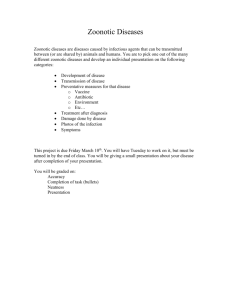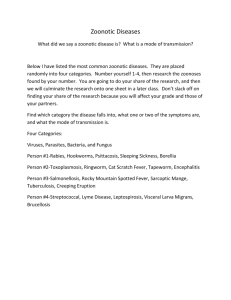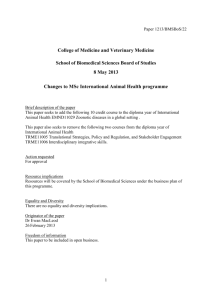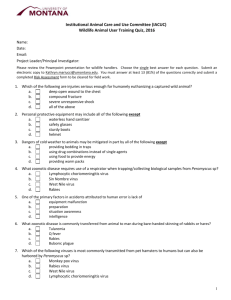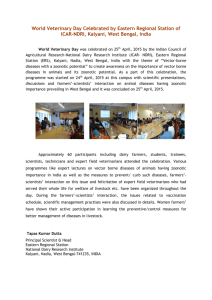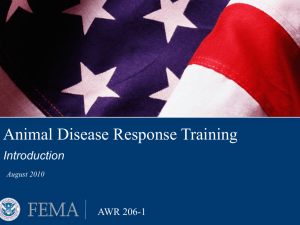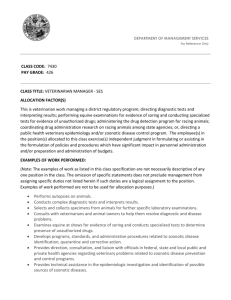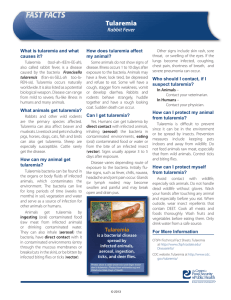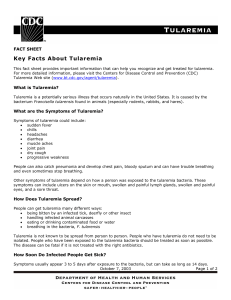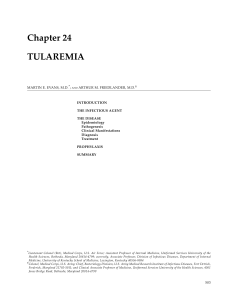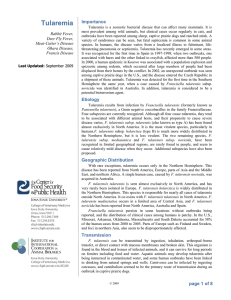Developing a Statewide Zoonotic Disease Surveillance System The Massachusetts Approach Pat Kludt MPH,
advertisement
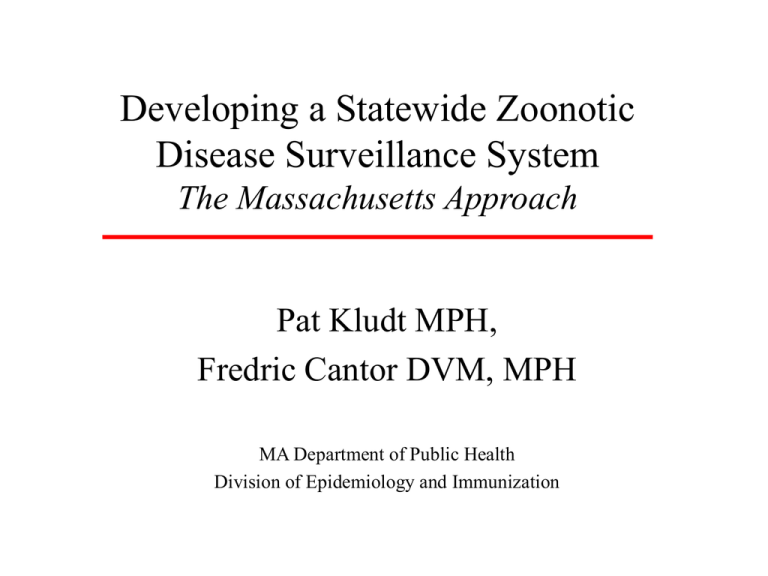
Developing a Statewide Zoonotic Disease Surveillance System The Massachusetts Approach Pat Kludt MPH, Fredric Cantor DVM, MPH MA Department of Public Health Division of Epidemiology and Immunization Why Does Public Health Care? • Animals can be sentinels for human disease • Animals can be reservoirs for human disease • Often unknown background rates of potential zoonotic disease • Reduce human risk by improving understanding of human exposures • Existing animal regulatory system outmoded • Animal ownership trends can increase risk of exposure to new diseases Human Surveillance System Tools Models for developing animal surveillance system • Regulatory Foundation – 105 CMR 300.000 • Case Definitions • Case Report Forms • Reporting Pathway Human Disease Reporting Pathway Healthcare Providers •Resources •Training Institutions Labs Others Local Boards of Health State Health Department CDC 4 Existing Zoonotic Disease Surveillance Systems • West Nile Virus – Mosquitoes, Birds & Horses • Rabies – Suspect animal exposures • Tularemia – Domestic Dogs and Cats – Pilot project on Martha’s Vineyard/Nantucket BT Cooperative Agreement for Emergency Preparedness Focus Area B: Epidemiology and Surveillance • Infectious Disease Response – Syndromic Surveillance – Isolation and Quarantine regulations – Electronic laboratory reporting • Vulnerability of food • Vulnerability of water • Animal Surveillance & Education Animal Surveillance and Education (ASE) • Membership: – Diverse, multi-agency representation • State/local public health, laboratory, animal health, animal control, wildlife agencies • Objectives – Improve animal event reporting and communication of zoonotic events. – Ensure epidemiologic response plans and emergency response plans incorporate issues related to highly contagious zoonotic diseases among animals. – In coordination with Education & Training Workgroup (Focus Area G), ensure the training of veterinarians, veterinary technicians and animal inspectors in BT topics and response. • Activities – Assess needs, provide ongoing project oversight Zoonotic Disease Tabletop Tool for Identifying Challenges -- Needs Assessment • • • • • • • Roles and responsibilities Regulations Personal protective equipment Specimen handling Laboratory testing Notification/Communication Disposal/Disinfection Developing a Zoonotic Disease Surveillance Program Animal Surveillance and Education Subcommittee Web Reporting & Database Development Agriculture Wildlife Surveillance, Serum Banking Sample Collection and Testing Protocols Tufts Vet School Protocol & Case Definition Development, Survey of Laboratory Practices Tufts/Agriculture/ Wildlife/MDPH Statewide Rabies Advisory Committee Developing a regulatory foundation Update Animal Control Regulations: Agriculture/Wildlife/MDPH Tularemia Serosurveillance MDPH Animal Disease Reporting Pathway VDLs Veterinarians Animal Control MA Div. of Animal Health, Biosecurity and Dairy Services Wildlife Rehab. MA Dept. of Fish & Game (MDFG) USDA / APHIS [ WS / VS / Animal Care] Web Reporting & Database Development Agriculture • Database development • Web-based disease reporting • Response protocol development – Reporting Forms – SOPs • Education of veterinarians Reportable Animal Diseases Animal Health Reporting Development of a web-based system Wildlife Surveillance & Serum Banking Tufts Veterinary School • Project planning – Multi-agency: agriculture, wildlife, public health (epi & lab),veterinary school • Limited scope – 2 disease syndromes: Sudden death, CNS – 4 diseases/agents: salmonella, ehrlichia, tularemia, arbovirus • • • • Protocol development Serum banking Sampling strategy development Necropsy guidelines and protocols Protocol & Case Definition Development, Survey Laboratory Practices Tufts in coordination with Agriculture/Wildlife/MDPH • Develop case definitions for zoonotic animal diseases – Coordinate with MDPH and Agriculture – Assist in development of response protocols • Develop, conduct and analyze survey of veterinary laboratory utilization practices Tularemia Serosurveillance Project MDPH / Agriculture • Short term goals – Baseline seroprevalence of tularemia in animals – Help veterinarians to understand risk to pets from exposure to tularemia – Increase pet owner’s knowledge and awareness of tularemia and measures to prevent exposures to themselves and their pets • Long term goals – Distribution and extent of tularemia exposures in dogs and cats on Martha’s Vineyard and Nantucket – Determine heightened areas/periods of tularemia activity – Evaluate dogs and cats as a sentinel tool for predicting human disease risk Animals as Sentinels for Tularemia • Serosurveillance in dogs and cats indicate human risk for exposure to tularemia on Martha’s Vineyard • Titers correlate with wild animal exposure and tick burden • Presumptive positives mostly in dogs, especially geriatric population • Need to sustain veterinary interest • Communicate results to public/ owners Legislative and Regulatory Review Rabies Advisory Committee Agriculture/Wildlife/MDPH • Review existing laws and regulations that apply to rabies and animal control • Suggest changes to these laws and regulations to: – Improve efficiency and effectiveness of animal disease response and control – Increase flexibility and adaptability of system to address emergent zoonotic diseases in domestic pets, livestock and wildlife Zoonotic Disease Surveillance System Essential Components • Communication & collaboration – Local/state/federal • • • • • • Rapid communication of results Rapid assessment of human risk Involvement of local health and animal control Identification of response and control measures Implementation of response and control measures Shared policies, procedures and protocols Integrated Disease Reporting Pathway “A Gold Standard” Healthcare Providers Institutions Local Health Labs VDLs Veterinarians + Local Health State Health (MDPH) CDC State Animal Health USDA Summary and Acknowledgements • We have come a long way in our collaborative efforts with our partners in the veterinary community but know we have much more to do • We would like to thank all our colleagues and collaborators on both the rabies advisory committee and the animal education and surveillance subgroup, in the public health laboratory and finally, our own epidemiologists on our zoonotic team for their continued participation and commitment to these projects
